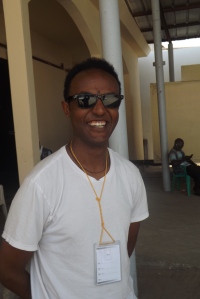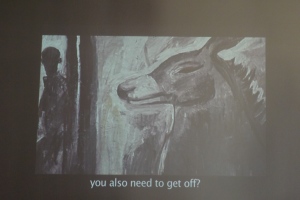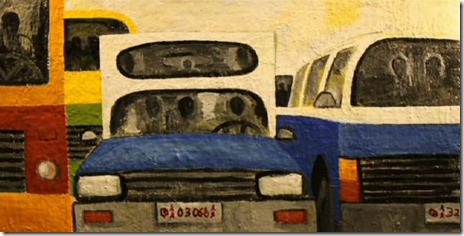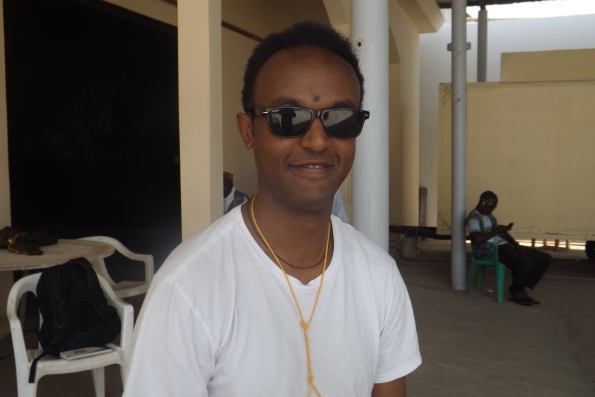Ezra Wube was born and raised in Addis Ababa, Ethiopia. He moved to the United States at the age of 18. He has had an illustrious and colourful career that has seen his work exhibited in various corners o f the globe. His work is memorable and there is no doubt that he set to go places. He was featured at the 2014 Dak’art Biennale and here is our chat.
f the globe. His work is memorable and there is no doubt that he set to go places. He was featured at the 2014 Dak’art Biennale and here is our chat.
Msanii Kimani: How does it feel to be at the Biennale?
Ezra Wube: I felt both greatly honored and emotional about participating in Dak’art Biennale
Msanii Kimani: Did you imagine that your work will be at a continental stage like this?
Ezra Wube: No, I didn’t think I would be in an exhibition with such influential artists and curators yet.
Msanii Kimani: Talk to me about Hisab? That is an Amharic name. What does Hisab mean?
Ezra Wube: Hisab literally means logic, fare, calculation or Math. In Ethiopia the word is used when someone asks a customer for their fare (in my animation, for instance, we hear a Taxi-man asking for the fare from the passengers).
Msanii Kimani: What inspired it?
Ezra Wube: Addis Ababa is currently in great transformation. New neighborhoods are appearing rapidly and old ones are vanishing at the same time. In this animation, I used the neighborhood I grew up in as a backdrop, voices are friends and family members. Perhaps the changing city inspired me to tell, document, and reflect a story of my neighborhood before it disappears. I felt like stop action (erasure) animation was a great means of reflecting these vanishing places and identities.
Msanii Kimani: What is the significance of the three characters—the goat, donkey and dog in this narrative?
Ezra Wube: These three characters are the most common animals in the urban areas of Ethiopia. The story elegantly uses the nature of these everyday animals as a metaphor for human drama. In the story the three animals ride a taxi, each to their own destination. The dog pays extra and doesn’t get his change back (+), the goat doesn’t pay the fare (-) and the donkey pays the exact fare (0). The story continues, “since then…” dogs chase after taxis wanting to get their change back, goats run away from taxis afraid they’ll be asked for what they owe, and donkeys block the road since they owe or are owed nothing and take their time crossing the street. For me this animation also reflects the never ending tension between modernity and tradition, change and stillness.
http://www.youtube.com/watch?v=TIEyKn5oPgw
Msanii Kimani: Tell me about Wenzu? What does Wenzu mean in Amharic?
Ezra Wube: Wenzu means the river. In the story, Mr. Hyena who is drinking water upstream accuses Ms. Donkey who is drinking water downstream of dirtying his water. Today in Ethiopia, many people know this story but no one knows its origin, history or author.
For this project, I built a greenhouse and planted a crop of beans. On a piece of glass suspended over the greenhouse, I used salt, tomatoes, onions, teff, and lentil to animate the story while the beans grew in the background. A still camera connected to a computer and mounted above the greenhouse captured each frame. This project is the most performative project I have ever done. Since I was documenting the growth of the plants, I could only work forward without rearranging or reshooting scenes. The still images and the sound from the original documentation of the story were edited together to complete the animation. The process was as experiential as the telling of the story, existing only for the moment, celebratory and temporal.
Msanii Kimani: What inspired it?
Ezra Wube: The story was told by my grandmother, Tafesech Zeleke, who raised me. She told me the story, Wenzu, in her kitchen. When she passed away I decided to make this piece.

Msanii Kimani: In this piece, you use the donkey again but also introduce a hyena. What is the significance of these animals/characters in this narrative?
Ezra Wube: Ethiopia has the second highest donkey population in the world (after China). Throughout the country donkeys are very common and so are hyenas. One can find both animals anywhere you go. There are many folktales that use these two animals. Hyenas are carnivorous and hunt donkeys. In Ethiopia donkeys are seen as slow and stubborn, a poor-man’s vehicle. They are associated with the lower class. Hyenas are associated with greed. The story is about class. The donkey speaks to the Hyena from the lower part of the stream while the Hyena is standing upstream. The hyena accuses the donkey of dirtying the water. The donkey responds to the hyena “don’t make an excuse to eat me, you are upstream and I am downstream”. The donkey is helpless and accepts the natural rule while confronting the hyena to do his job without excuses. I feel like the story is also about food and survival, so I used food to make the animation.
http://www.youtube.com/watch?v=GeiAD0VBCl4
Msanii Kimani: Hisab and Wenzu are fabulous narratives that are grounded in important Ethiopian folktales. What do folktales mean to you as a visual artist?
Ezra Wube: Folktales to me are cultural identities that narrate the values, the history, the philosophies, the mythologies, the dreams and even the aesthetics of a given culture. Usually folktales have no original singular author. As an artist I’m interested in the authorless-ness of these communal stories. They can be recycled, rearranged, assimilated or appropriated and still remain authorless. The absence of a singular creator interests me with the possibility to adapt, change or morph the stories to a given geographical or cultural context.
Msanii Kimani: How did you come across these folktales?
Ezra Wube: The project was part of a larger story collection project in which I traveled for four months throughout Ethiopia collecting folklore. The intention was to document these oral traditions that are vanishing due to an influx of media (television). Most of my collection was from the rural parts of Ethiopia but I eventually returned back to where I grew up, Addis Ababa and thought about the folktales of my neighborhood.

Msanii Kimani: Would you describe yourself as a storyteller?
Ezra Wube: Yes, as an artist my art work involves time and place and that makes me a story teller (whether it’s a communal or individual story).
Msanii Kimani: You told the organisers of the 2014 Dak’Art Biennale that “folktales are not as much about what it narrates but how they are told and what they represent in a contemporary setting.” What does this mean in view of the two pieces— Hisab and Wenzu?
Ezra Wube: When one tells a story, there are several layers of communication; the language, the place, the time, the characters, the message (meaning) and also the direct interaction between the teller and the listener. These stories are oral traditions, meaning they live and transform from one telling to another, changing and adapting a little bit each time. Sometimes I found different versions of the same story told in several locations, each time adopting to the place’s cultural aesthetic. I use my own autobiography as a means to tell a story. I am inspired by having a direct experience, and also find it easier to talk about only things I know.
Msanii Kimani: What do they represent in the contemporary setting?
Ezra Wube: In a contemporary setting, they represents a merging of tradition and modernity. The process of making both animations was tactile and authentic (Hisab was painted on a single canvas, Wenzu was animated using food) however the only thing that is left now is the digital documentation (0s and 1s). This is a means to preserve the past as it vanishes and move forward with technology and digital media.
Msanii Kimani: You were born and grew up in Ethiopia but now live and work in the United States of America. Does the “contemporary setting” in these narratives describe your “two worlds” or the world in general?
Ezra Wube: In both animations the contemporary setting describes for me the world in general, Ethiopia, tradition and modernity. I do have some other work that directly engages both worlds that I am part of.

Msanii Kimani: Did you develop them at the same time? What is memorable about Hisab and Wenzu?
Ezra Wube: I made Hisab first and then Wenzu, but it was really one right after the other (I was very motivated).
Msanii Kimani: Have these pieces been exhibited elsewhere?
Ezra Wube: Hisab has been exhibited in “The Magmart Selection at FIVAC”, Camaguey, Cuba, “Filmfest Dresden International Short Film Festival”, Dresden, Germany, “Urban Research: Exploring Contemporary Urban Space”, Berlin, Germany, “The 30th Environmental International Film Festival”, Paris, France, “Colours of the Nile International Film Festival”, Addis Ababa, Ethiopia (best short film), “Animated Dreams”, Tallinn, Estonia, “Vuotociclo”, video art show, University Suor Orsola Benincasa, Naples, Italy, “International Leipzig Festival for Documentary and Animated Film”, Leipzig, “Animation Screenings”, Neuberger Museum of Art, Purchase, NY, “Roof Top Films”, Brooklyn, NY, “Milano Film Festival”, Milan, Italy, “Melbourne International Animation Festival”, Melbourne, Australia, “Swedenborg Short Film Festival”, London, UK (best short film), “Afrika in Motion Film Festival”, Edinburgh, Scotland, “Silicon Valley African Film Festival”, Mountain View, CA, “Ottawa Animation Festival”, Ottawa, Canada, “International Black Film Festival”, Nashville, TN, “Annecy International Animation Festival”, Annecy, France, “4×4”, San Jose Institute of Contemporary Art, San Jose, CA and Dak’Art 2014 Biennale, Senegal.
Wenzu on the other hand has only been exhibited at “The 18th International Festival of Contemporary Art SESC_Video Brasil”, São Paulo, Brazil, Euganea film festival and Dak’Art 2014 Biennale.
Msanii Kimani: What kind of reception has it received?
Ezra Wube: Both pieces were well received from the personal to institutional level. They were also able to be part of both the fine art and the film worlds.
Msanii Kimani: Please give me some highlights of: your happiest moments; your trying/challenging time while developing this series?
Ezra Wube: Both shorts were made while traveling between Ethiopia and USA, which was a bit challenging considering time, cost, and geography. One of my happiest moments was when I screened Hisab in the streets of Addis Ababa, paralleling the imagination with the real, it was incredible.
Msanii Kimani: How can you describe yourself?
Ezra Wube: I am a 33 year old visual artist. I am married and the father of an amazing little girl. In my work I am interested in time, place and memory.
Msanii Kimani: Who would you say is Ezra Wube? Take me through the journey of your life.
Ezra Wube: I was born and raised in Addis Ababa Ethiopia. I grew up in one of the largest markets in Africa, Mesalemiya Merkato. I was raised by my fraternal grandmother. When I turned 18 my biological father brought me to the U.S.A. to go to college. I have been living and working in New York in and out for almost 10 years.
Msanii Kimani: Where did you go to school?
Ezra Wube: In Ethiopia I went to Bethelehm public school for elementary and Yekatit 12 public school for high school. I have a Bachelor’s degree in Painting from Massachusetts College of Art, Boston and a Master of Fine Art degree from Hunter College, New York in combined media.
Msanii Kimani: What are some of the memorable thoughts of your life while you were growing up?
Ezra Wube: A memorable experience from my childhood was once my friends and I found a dead ladybug and we thought it was the praying mantis (which is considered a sacred insect in Ethiopia). We treated the insect as if it was a human being. We had a three day mourning and burial service for the insect, getting lots of attention from neighbors. It was real.
Msanii Kimani: What did you want to do in life? Did you always want to be an artist?
Ezra Wube: When I was a kid I wanted to be a lawyer, then a computer scientist, I also really liked biology. I actually never decided to become an artist. In my first year of college I took all the required classes such as computer science, physics, geography and English but I had an open elective so I decided to take a drawing class. I enjoyed it and felt at home. The next year I wanted to take a painting class but the school told me I had to be a major to take the class. I majored in art and everything felt natural.
Msanii Kimani: What prompted you to choose your career as an artist?
Ezra Wube: I believe that once I chose the road to become an artist I felt I could grow, I could keep going.
Msanii Kimani: You went to the USA when you were already grown up. Had you started working as an artist before you went there?
Ezra Wube: I always did art as a hobby. I began painting as a child using food coloring and spices. My uncle saw the way I used the pigments (with thick surface) and suggested I try oil painting. When I was in high school I participated in an HIV poster art contest. I won $5 and bought my first oil painting set. I then began painting on wood, wall and canvas.
Msanii Kimani: How has it been working in the USA? How is different from Ethiopia?
Ezra Wube: In the USA there are plenty of art supplies and quality brands (if you can afford them). Recently I was in Ethiopia and I wanted to make a painting. It was very difficult finding a good brand, there were almost no choices. The paint quality was very poor and I felt sympathetic for artist living in Ethiopia.
Conceptually, making artwork about Ethiopia and living in the USA was difficult. It’s like the body and the mind is separated. However, the USA is not all of what I am and Ethiopia is thousands of miles away. I even tried to blend these two cultural experiences which became full of paradox. Now I feel like it’s best to reflect a project based on the concept rather than a geographical region. I am from Ethiopia but I live in the USA and have a family here too, both places are home to me. It’s like having two mothers, birth and adoptive.
Msanii Kimani: You have participated in several visual art and animated movies festivals around the world. Tell me how this has been?
Ezra Wube: I feel very lucky to be part of all the festivals and shows I have attended, traveling worldwide, Asia, Europe, South America and Africa. I have met incredible people.
Msanii Kimani: Where do you draw inspiration for your work? Who was (were) your role model(s) in the industry?
Ezra Wube: I find inspiration in day to day living. I greatly appreciate, admire and am thankful to a wide range of thoughts and discussions in the art world, though I never had an ideal artist that I wanted to be.
Msanii Kimani: We all have some lousy moments. Have you had such?
Ezra Wube: There were a few lousy moments. Once I had a presentation at a college. I spent money on materials and traveled for hours to get there. When I arrived, there were only two members in the audience, the event organizer and the security guard. I also once had over US $2000 worth of art supplies vanish after an airline lost my luggage.
Msanii Kimani: Politics is discussed in a very subtle way in your work. What is your opinion of art and politics in Africa?
Ezra Wube: I believe it is a very exciting era for Africa, especially since the digital world is giving us access to vast amounts of information (of course unfortunately it is filtered to various degrees). In politics, Africa has a long way to go.
Msanii Kimani: Should artists be actively engaged in political discourse through their work?
Ezra Wube: I believe it’s impossible not to be political, every art work is political one way or another. Simply having a name is political. For instance in the past artists made abstract art in an effort for the work not to refer outside itself. They wanted to make art in its purest form (art for art sake) and to defy any social realities, to me that is political itself. I believe artists are part of society and reflecting it is an artistic responsibility.
Msanii Kimani: What are some of the other big names that you have worked with in the industry? How did that feel?
Ezra Wube: Last year, I had my animation displayed in at the famous Time Square, New York for a month on the biggest screens for thousands of people. It was incredible!
Msanii Kimani: What would you tell the young upcoming artists? What should they do and avoid doing?
Ezra Wube: Listen to yourself but keep your ears open. What to avoid? Do not be satisfied easily, your work must shatter the walls and change society for the better, forever.
Msanii Kimani: What are some of the other extraordinary things that have happened to you and also added invaluable experience to your life as an African contemporary artist?
Ezra Wube: Growing up I watched tons of Kungu Fu movies which eventually inspired me to go to Shaolin China for training. I stayed there for a couple of months training six days a week 5 am- 9pm. It was one of the most extraordinary things that ever happened to me. I learned some Mandarin as well.
Sometimes I am faced with a social expectation of what is to be an African artist, as if you are a meal a menu. As an artist from Africa I intend to challenge and broaden that perception.
Msanii Kimani: What are the other things that you like doing when you are not working? What are your hobbies etc.?
Ezra Wube: My hobbies, I like walking, practicing Tai-chi, playing my guitar, cooking, and sometimes doing nothing.
Msanii Kimani: What are you currently working on?
Ezra Wube: I am currently working on a commissioned animation short that will be screened at the Museum of Moving Image in New York. The animation is based on my own experiences walking in the four directions from the museum (north, south, east and west).
Msanii Kimani: Where do you see yourself in 20-years?

Ezra Wube: To have an art center in Ethiopia.
Biography
In 2003, Ezra was awarded the Massachusetts Annual Black Achievement Award and held his first one-person show at the Dreams of Freedom Museum in Boston, MA. In 2004, he received his Bachelors of Fine Arts from Massachusetts College of Art.
Upon graduation, Ezra received a Dondis and Godine Travel Fellowship to conduct research in Ethiopia on folktales and traditional lore. In 2006, he held his second solo show Story Telling, at the United Nations. The following year, Ezra was part of the Ethiopian Millennium art show at the Blackburn Gallery of Howard University in Washington, DC.
In 2008, Ezra participated in Reflections in Exile: Five Contemporary African Artists Respond to Social Injustice at the South Shore Art Center in Cohasett, MA, Here to There at the South Seattle Community College in WA, Washington, and Abyssinia to Harlem and Back at the Canvas Paper and Stone Gallery in New York.
In 2009, Ezra received the Pamela Joseph Art Scholarship while working on his Masters of Fine Arts thesis at Hunter College in New York. He also participated in The Happening: Kinetics as Art Object at the Rush Arts Gallery in New York, MA selects MFA at Hunter College New York, Freeze Frame throughout Miami and the Bina Film Festival in New York. In 2010, Ezra participated in a group art show at BAM in Brooklyn.
In 2011 Ezra participated in Art & the City, Cologne OFF 2011 Morocco, Swedenborg Short Film Festival, UK, Contemporary Artists Center in New York and The Substation in Johannesburg, South Africa.
In 2012, his videos screened in several festivals such as The Libelula Animation Festival in Spain, The 16th International Video Festival VIDEOMEDEJA at the Museum of Contemporary Art of Vojvodina, Novi Sad, Serbia, The Migratory Photo Project in New York, International Short Film Festival in Berlin, Video Art Festival in Moscow Museum of Modern Art, “Animate COLOGNE at the Cologne Art & Animation Festival, etc.
In 2013 Ezra was an artist in residency at the LMCC Swing SPACE program and his completed piece screened in Timesquare as their midnight moment program. He was also and received Van Lier Fellowship.
This year, he has participated at the 2014Dak’Art Biennale and his work has been featured at the Kampala Art Biennale, Video in Progress 5: Reflections of the Past in Slovenia, the One Minutes Series – Animation, Power Station of Art in Shanghai, Total Art – Movement to Imagination, CologneOFF 2014 in Ecuador etc.


Great interview, wonderful animation and emotional art, well done.
Thank you Paul. Encouraging words there.
Reblogged this on African Perspectives.
Pingback: Ezra Wube, past and present with an unique technique | Open to Ethiopia
Pingback: traiteur rabat